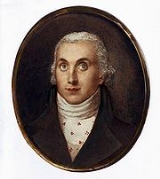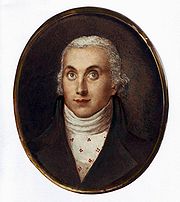
Paul Ludwig Simon
Encyclopedia

Germany
Germany , officially the Federal Republic of Germany , is a federal parliamentary republic in Europe. The country consists of 16 states while the capital and largest city is Berlin. Germany covers an area of 357,021 km2 and has a largely temperate seasonal climate...
architect
Architect
An architect is a person trained in the planning, design and oversight of the construction of buildings. To practice architecture means to offer or render services in connection with the design and construction of a building, or group of buildings and the space within the site surrounding the...
and professor at the Building Academy (Bauakademie
Bauakademie
The Bauakademie in Berlin, Germany, built between 1832 and 1836, is considered one of the forerunners of modern architecture due to its theretofore uncommon use of red brick and the relatively streamlined facade of the building.Designed by Karl Friedrich Schinkel, the Bauakademie was built near...
) in the faculty of architectural physics and a privy architectural counsellor at the Prussian Higher Council of Architecture (Preußische Oberbaudeputation) in Berlin. In the latter position Simon was the predecessor of Karl Friedrich Schinkel
Karl Friedrich Schinkel
Karl Friedrich Schinkel was a Prussian architect, city planner, and painter who also designed furniture and stage sets. Schinkel was one of the most prominent architects of Germany and designed both neoclassical and neogothic buildings.-Biography:Schinkel was born in Neuruppin, Margraviate of...
. Simon was serving as well as Senior Director of public works for the Marches of Pomerania and Prussia. Beside these fields of activity Simon did – at that time in Europe well known – research work in the field of Electrochemistry
Electrochemistry
Electrochemistry is a branch of chemistry that studies chemical reactions which take place in a solution at the interface of an electron conductor and an ionic conductor , and which involve electron transfer between the electrode and the electrolyte or species in solution.If a chemical reaction is...
and Galvanism
Galvanism
In biology, galvanism is the contraction of a muscle that is stimulated by an electric current. In physics and chemistry, it is the induction of electrical current from a chemical reaction, typically between two chemicals with differing electronegativities....
. He published different articles on these subjects in German scientific journals – as for example “Physics Annual” (Annalen der Physik
Annalen der Physik
Annalen der Physik is one of the oldest physics journals worldwide. The journal publishes original, peer-reviewed papers in the areas of experimental, theoretical, applied and mathematical physics and related areas...
).
Life
Born in Berlin, Simon was a descendant of French Huguenots, who had taken refuge in Brandenburg-PrussiaBrandenburg-Prussia
Brandenburg-Prussia is the historiographic denomination for the Early Modern realm of the Brandenburgian Hohenzollerns between 1618 and 1701. Based in the Electorate of Brandenburg, the main branch of the Hohenzollern intermarried with the branch ruling the Duchy of Prussia, and secured succession...
. After a two-year period of training at the Academy of Arts (Akademie der Künste
Akademie der Künste
The Akademie der Künste, Berlin is an arts institution in Berlin, Germany. It was founded in 1696 by Elector Frederick III of Brandenburg as the Prussian Academy of Arts, an academic institution where members could meet and discuss and share ideas...
) in October 1789 Simon was hired to serve as a “special director” at the Royal Building Administration (Königliches Oberhofbauamt). In 1791 he was leading the new construction of the Reeve Building (Stadtvogtei) in Berlin as the superior of Friedrich Gilly
Friedrich Gilly
Friedrich David Gilly was a German architect and the son of the architect David Gilly.Born in Altdamm , Pomerania , Gilly was known as a prodigy and the teacher of the young Karl Friedrich Schinkel. In 1788 he enrolled at the Akademie der Bildenden Künste in Berlin...
.
In November 1798 Simon was appointed professor at the Academy of Arts in Berlin and one year later – at the same time of the foundation of the new Building Academy in Berlin – professor in the faculty of architectural physics.
In 1804 Simon joined the Prussian Higher Council of Architecture as a privy architectural counsellor and became Senior Director of public works for the Marches of Pomerania and Prussia in 1809.
According to family lore Simon accompanied Prussian Queen Luise on her flight from Berlin to Tilsit in October 1806 during the French military occupation of Napoleon in Prussia, as his professional activities afforded him rights of travel that enabled the Prussian Queen an inconspicuous passage.
Among other buildings Simon reconstructed the Palais Wilhelmstraße 76 (since 1819 the Prussian Ministry of Foreign Affairs) for the Russian Diplomatic Representative Minister Alopeus in 1805 and the Palais Wilhelmstraße 65 (later the Prussian Ministry of Justice) for Prinz Ferdinand in 1809-1813.
During 1809-1811 the new Higher Civil Court (Oberlandesgericht) in Königsberg
Königsberg
Königsberg was the capital of East Prussia from the Late Middle Ages until 1945 as well as the northernmost and easternmost German city with 286,666 inhabitants . Due to the multicultural society in and around the city, there are several local names for it...
was built according to Simon’s plans.
As a private architect Simon worked for Elisabeth von Humboldt – the mother of Wilhelm
Wilhelm von Humboldt
Friedrich Wilhelm Christian Karl Ferdinand Freiherr von Humboldt was a German philosopher, government functionary, diplomat, and founder of Humboldt Universität. He is especially remembered as a linguist who made important contributions to the philosophy of language and to the theory and practice...
and Alexander von Humboldt
Alexander von Humboldt
Friedrich Wilhelm Heinrich Alexander Freiherr von Humboldt was a German naturalist and explorer, and the younger brother of the Prussian minister, philosopher and linguist Wilhelm von Humboldt...
– by constructing the Humboldt family crypt in Falkenberg.
Between 1804 and 1806 Simon constructed the estates and manor houses of Tempelberg and Gölsdorf for the Prussian Prime Minister Karl August von Hardenberg
Karl August von Hardenberg
Karl August Fürst von Hardenberg was a Prussian statesman and Prime Minister of Prussia. While during his late career he acquiesced to reactionary policies, earlier in his career he implemented a variety of Liberal reforms...
.
In January 1789 Simon married Marie Madelaine Royer, who was also a descendant of French Huguenots. They had four children. The eldest son Friedrich Louis Simon
also became Prussian architect.
Simon died at the age of 44 in Berlin.

